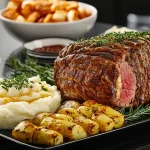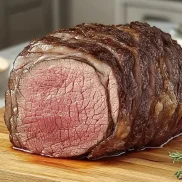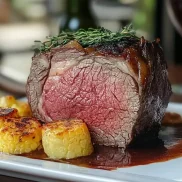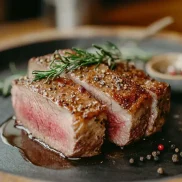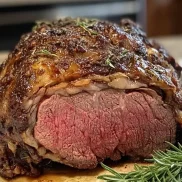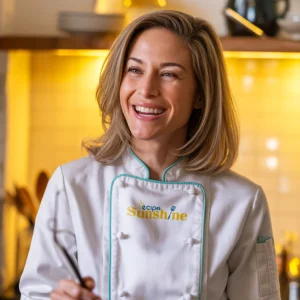When it comes to culinary indulgence, few dishes rival the sheer elegance and flavor of a perfectly roasted prime rib. This centerpiece of countless festive tables is a showstopper, capable of delighting even the most discerning palates. But before you dive into the cooking process, there’s an important question to consider: What is the most important thing to do before roasting a prime rib roast? The answer lies in preparation, a crucial step that sets the foundation for a mouthwatering masterpiece. Whether it’s selecting the right cut or perfecting your prime rib roast rub recipe, preparation is the key to success.
In this guide, we’ll explore the essentials of preparing prime rib to ensure that every bite is tender, juicy, and bursting with flavor. Let’s embark on this savory journey together, starting with understanding the marvel that is prime rib.
Table of Contents
Understanding the Prime Rib: A Culinary Marvel
The prime rib, also known as a standing rib roast, holds a special place in the world of gourmet cuisine. It’s a cut of beef that exudes luxury, revered for its marbling, tenderness, and rich flavor. But what makes it so extraordinary? Let’s uncover its secrets.
What Makes a Prime Rib Special?
At the heart of the prime rib’s appeal is its unique composition. This cut is taken from the primal rib section of the cow, which spans ribs six through twelve. It’s celebrated for its generous marbling — the fine streaks of fat woven through the meat that melt during cooking, infusing it with flavor and keeping it moist.
The prime rib’s tenderness also sets it apart. Unlike cuts from the more active parts of the cow, this section sees less movement, resulting in softer muscle fibers. When cooked properly, this tenderness transforms into a buttery texture that’s nothing short of heavenly.
Additionally, the prime rib is versatile in its flavor profile. It’s the ideal canvas for a variety of seasonings, whether you prefer a classic garlic and herb rub or a more adventurous spice blend. Its rich beefy flavor pairs beautifully with both traditional and modern accompaniments, making it a star at any gathering.
Different Cuts of Prime Rib: Bone-In vs. Boneless
One of the first decisions you’ll face when selecting a prime rib is whether to opt for a bone-in or boneless cut. Both have their merits, and your choice depends on your preferences and cooking goals.
- Bone-In Prime Rib: This traditional option includes the rib bones, which serve as a natural roasting rack. The bones contribute additional flavor and help insulate the meat, leading to more even cooking. Plus, a bone-in roast often makes for a striking presentation, adding a rustic charm to your meal. However, it can be slightly more challenging to carve, requiring a bit of finesse.
- Boneless Prime Rib: For those who prioritize ease of preparation and serving, a boneless cut is a fantastic choice. It’s simpler to season, cook, and slice, making it a practical option for novice cooks. While it may lack the added flavor from the bones, proper seasoning and cooking techniques can easily compensate.
Understanding these nuances ensures you select the prime rib that best suits your needs and preferences. With this foundational knowledge, you’re one step closer to crafting a roast that will impress your guests and leave them craving more. In the next sections, we’ll delve deeper into preparation techniques, seasoning, and roasting methods to help you achieve perfection.
Selecting the Perfect Prime Rib for Roasting
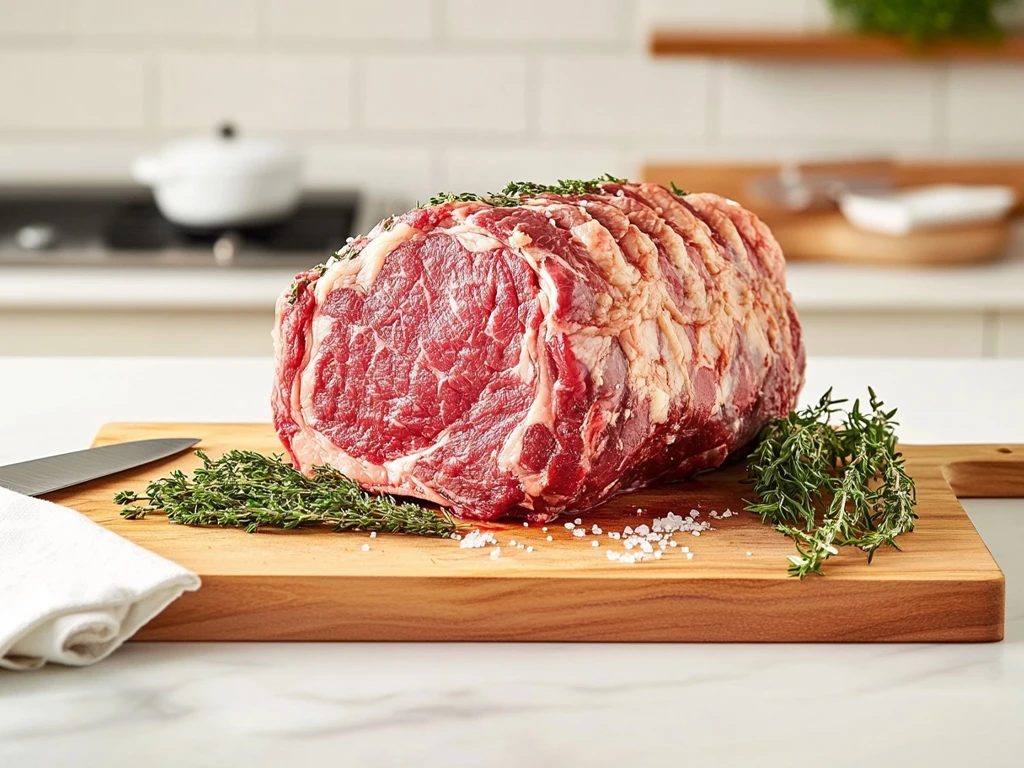
Choosing the right prime rib is a crucial first step toward a flavorful and successful roast. With so many options available, selecting the best cut can feel overwhelming. By focusing on three key factors—grade, size, and sourcing—you can ensure your prime rib is nothing short of exceptional.
How to Choose the Best Grade of Prime Rib
The grade of a prime rib determines its quality, flavor, and tenderness. In the United States, beef is graded by the USDA into three main categories: Prime, Choice, and Select.
- Prime Grade: This is the highest quality, featuring abundant marbling and superior tenderness. Prime-grade beef is often found in high-end restaurants and specialty butcher shops. While it’s more expensive, the exceptional flavor and texture make it worth the splurge for special occasions.
- Choice Grade: Slightly lower in marbling than Prime, Choice-grade beef is still an excellent option for a prime rib roast. It’s widely available in supermarkets and offers a great balance between quality and affordability.
- Select Grade: With less marbling, Select-grade beef tends to be leaner and less flavorful. While it’s a budget-friendly option, it may require additional techniques, like marinating, to enhance its tenderness and taste.
When choosing your prime rib, prioritize marbling. The intricate web of fat running through the meat ensures it stays juicy and flavorful during roasting.
Evaluating the Weight and Size for Your Occasion
Once you’ve settled on a grade, the next step is to determine the right weight and size of the roast. This decision depends on the number of guests you’re serving and whether you’d like leftovers.
- Portion Guidelines: A general rule of thumb is to allocate one pound of raw prime rib per adult. This accounts for the bone weight and shrinkage during cooking, ensuring everyone gets a satisfying portion.
- Bone-In vs. Boneless: If you opt for a bone-in roast, remember that the bones will add to the overall weight. A three-bone roast typically weighs about 6-8 pounds and serves 6-8 people. A boneless roast, on the other hand, is easier to carve and calculate portions.
- Occasion and Leftovers: For special celebrations, consider a slightly larger roast to provide generous servings and allow for leftovers. Leftover prime rib can be transformed into delicious sandwiches, soups, or hash, extending the enjoyment of your meal.
Sourcing High-Quality Prime Rib from Local and Online Markets
Finding a reliable source for high-quality prime rib is just as important as selecting the right cut. Whether you choose a local butcher or an online supplier, these tips can help you make an informed decision:
- Local Butcher Shops: Local butchers are often a treasure trove of premium meats. They can guide you through the selection process, offer custom cuts, and provide valuable cooking tips. Building a relationship with a trusted butcher ensures consistent quality and personalized service.
- Supermarkets: Many large supermarkets carry a variety of prime rib options, particularly during the holiday season. Look for vacuum-sealed packages with clear labeling on the grade and weight.
- Online Suppliers: For convenience and access to specialty products, online meat suppliers are an excellent choice. Companies like Snake River Farms and Omaha Steaks offer high-quality options shipped directly to your door. Be sure to read customer reviews and check for guarantees on freshness and quality.
By carefully considering grade, weight, and sourcing, you’ll be well on your way to selecting a prime rib that’s perfect for roasting. In the next section, we’ll delve into essential preparation techniques to elevate your roast to new heights.
What Is the Most Important Thing to Do Before Roasting a Prime Rib Roast? Critical First Steps
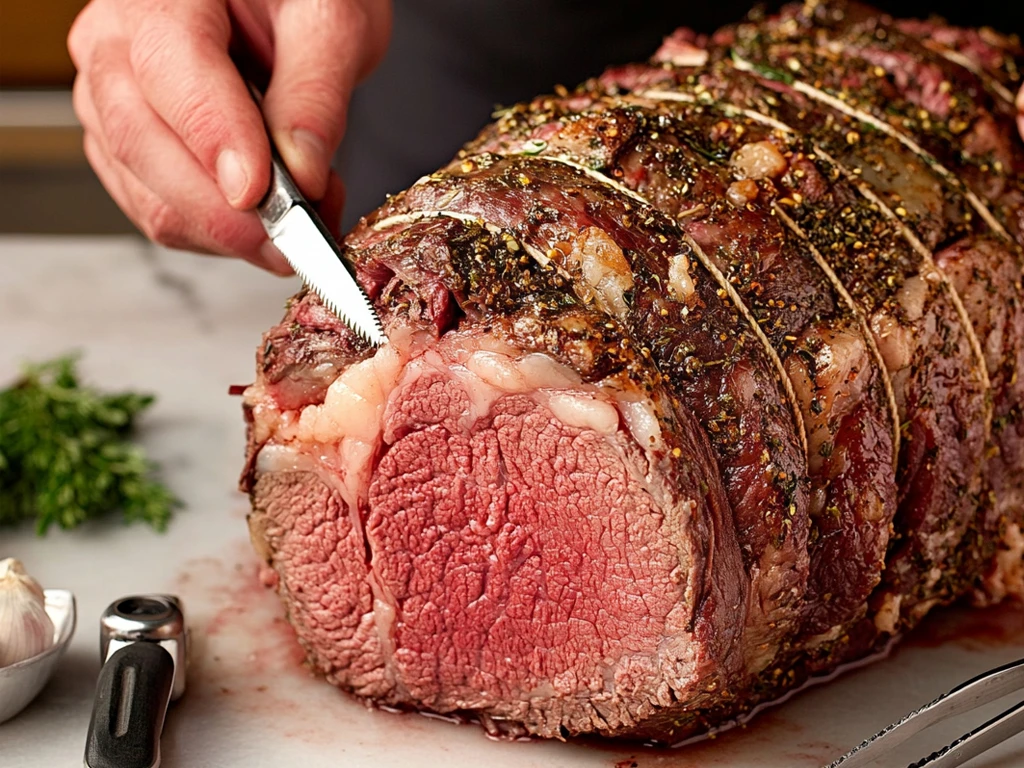
The preparation of a prime rib roast is the key to unlocking its full potential. These critical first steps ensure your roast is seasoned to perfection, cooks evenly, and retains its juicy tenderness. Let’s dive into the essential tasks that set the foundation for an unforgettable prime rib experience.
Why Tempering the Meat Is Essential
Tempering, or allowing the meat to come to room temperature, is a vital step that many overlook. This process ensures the roast cooks evenly and prevents the exterior from overcooking while the interior remains underdone.
- The Science Behind Tempering: Cold meat placed directly in a hot oven leads to uneven cooking. Tempering allows the internal temperature of the meat to rise gradually, reducing the cooking time and improving texture and flavor.
- Practical Benefits: Tempering enhances the roast’s juiciness, as the meat retains its moisture better when cooked at a more consistent temperature.
How Long Should You Let It Rest at Room Temperature?
The length of time your roast should rest depends on its size:
- For smaller roasts (4-6 pounds): Allow 1-2 hours of resting time at room temperature.
- For larger roasts (7-10 pounds or more): Plan for 3-4 hours of resting time.
During this period, keep the roast covered lightly with foil or plastic wrap to prevent it from drying out. Avoid skipping this step, as it’s one of the most important things to do before roasting a prime rib roast.
Trimming the Fat Cap for Optimal Results
The fat cap, the thick layer of fat on the top of a prime rib, plays a crucial role in flavor and moisture retention. However, proper trimming is essential to avoid excessive greasiness while allowing the meat to develop a beautiful crust.
- Why Trim the Fat Cap?: Leaving too much fat can make the roast overly greasy, while trimming it entirely can dry out the meat. The goal is to leave about ¼ inch of fat, which renders down during cooking, infusing the roast with rich flavor.
- How to Trim: Use a sharp knife to carefully shave off excess fat, following the contours of the meat. Be sure to leave a thin, even layer for the best results.
Tying the Roast for Even Cooking
Tying, or trussing, the roast is another critical step that ensures uniform cooking and an attractive presentation.
- Why Tie the Roast?: A tied roast maintains its shape during cooking, which helps it cook evenly. This is particularly important for boneless cuts, as they tend to flatten out without support.
- How to Tie: Using butcher’s twine, loop the string around the roast at 1-2 inch intervals. Tie each loop snugly, but not so tight that it cuts into the meat. If you’re using a bone-in roast, secure the twine around the bones as well for added stability.
By mastering these preparation techniques, you’ll set the stage for a perfectly roasted prime rib. In the next section, we’ll explore seasoning strategies that take your roast from good to extraordinary.
The Role of Seasoning: Infusing Flavor from the Start
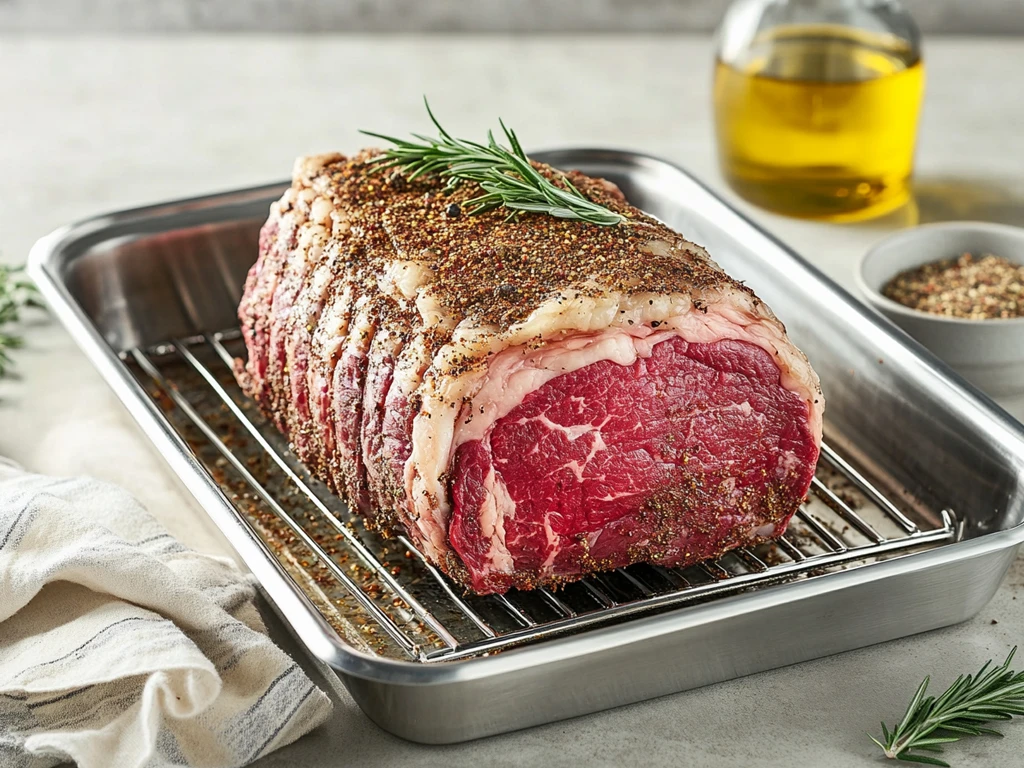
Seasoning a prime rib is more than just an afterthought; it’s a transformative process that elevates this exquisite cut of meat to its full potential. The right seasoning technique infuses flavor deep into the roast, creating a harmonious balance of taste and texture. Whether you’re a fan of bold dry rubs or the nuanced depth of marinades, understanding these methods is key to mastering the art of seasoning.
Dry Rubs vs. Marinades: What Works Best?
Choosing between a dry rub and a marinade depends on your desired flavor profile and the time you have to prepare your roast.
- Dry Rubs: Ideal for those seeking a concentrated burst of flavor, dry rubs combine spices, herbs, and salt to create a flavorful crust. They’re easy to apply and require less preparation time. The salt in a dry rub draws out moisture from the meat’s surface, helping to form a beautiful caramelized crust during roasting.
- Marinades: For a deeper infusion of flavor, marinades are a great option. Comprising liquid bases like wine, vinegar, or soy sauce, combined with herbs and spices, marinades penetrate the meat to tenderize and add complexity. However, marinades need several hours or even overnight to work their magic, making them a better choice if you have ample preparation time.
While both methods have their strengths, many chefs recommend a combination: a marinade for tenderness and flavor depth, followed by a dry rub for a bold, seasoned crust.
Essential Ingredients for a Classic Prime Rib Rub
A classic prime rib rub enhances the natural flavors of the beef without overpowering them. Here are the staple ingredients for a foolproof dry rub:
- Salt: The foundation of any seasoning blend, salt draws out moisture and enhances the meat’s natural flavors.
- Black Pepper: Coarsely ground black pepper adds a robust, slightly spicy kick.
- Garlic Powder: A savory addition that complements the richness of the beef.
- Onion Powder: Provides a subtle sweetness and depth.
- Herbs: Fresh or dried rosemary and thyme bring earthy, aromatic notes to the roast.
- Optional Spices: Paprika for smokiness or cayenne pepper for heat can be added to personalize your rub.
To apply, generously coat the entire surface of the roast, ensuring the rub adheres well. For best results, let the seasoned meat rest in the refrigerator for several hours or overnight to allow the flavors to meld.
Advanced Techniques: Dry Aging for Enhanced Flavor
For those looking to take their prime rib to the next level, dry aging is a technique worth exploring. Dry aging involves storing the meat in a controlled environment for several weeks, allowing natural enzymes to break down muscle tissue and intensify flavor.
- Benefits of Dry Aging: This process concentrates the beef’s natural umami flavors, enhances tenderness, and develops a unique nutty, buttery taste that’s impossible to replicate with other methods.
- How to Dry Age: At home, dry aging requires a dedicated refrigerator or a controlled space with consistent airflow and temperature (34-38°F). Wrap the roast in cheesecloth or a clean kitchen towel and let it age for 7-14 days, changing the wrapping every few days.
While dry aging requires patience and careful monitoring, the payoff is a flavor experience that’s second to none.
By understanding and mastering seasoning methods, you’ll infuse your prime rib with flavors that linger long after the last bite. Up next, we’ll delve into the art of roasting, focusing on techniques that bring out the best in your carefully seasoned prime rib.
Frequently Asked Questions
What is the best way to season a prime rib?
The best way to season a prime rib is by using a well-balanced dry rub made of salt, black pepper, garlic powder, onion powder, and fresh or dried herbs like rosemary and thyme. Generously apply the rub to all sides of the roast and allow it to rest for several hours or overnight in the refrigerator. This ensures the flavors deeply penetrate the meat and creates a delicious crust when roasted. Learn more
Should you rub a prime rib the night before?
Yes, rubbing a prime rib the night before is highly recommended. Allowing the seasoned roast to rest in the refrigerator overnight gives the spices and herbs time to meld with the meat, resulting in a more flavorful roast. Be sure to bring the roast to room temperature before placing it in the oven to ensure even cooking. Learn more
How do restaurants make prime rib so tender?
Restaurants achieve tender prime rib through a combination of high-quality meat selection, precise cooking techniques, and resting periods. Many use slow roasting at a low temperature, followed by a brief high-heat sear to develop a crust. Additionally, some restaurants use dry aging to enhance the meat’s tenderness and flavor. Learn more
How long should a prime rib rest before carving?
After removing the prime rib from the oven, let it rest for at least 20-30 minutes before carving. This resting period allows the juices to redistribute throughout the meat, ensuring each slice is juicy and flavorful.
Can you overcook a prime rib?
Yes, overcooking a prime rib can result in dry and tough meat. To avoid this, use a meat thermometer and remove the roast from the oven when it reaches your desired doneness temperature (e.g., 120°F for rare, 130°F for medium-rare). The internal temperature will continue to rise during resting.
What are the best sides to serve with prime rib?
Prime rib pairs beautifully with classic sides like garlic mashed potatoes, roasted vegetables, Yorkshire pudding, and creamy horseradish sauce. For a more modern twist, consider serving it with truffle mac and cheese or a vibrant arugula salad with citrus vinaigrette.
Conclusion
Mastering the art of preparing and roasting a prime rib is a rewarding culinary endeavor. By understanding the importance of tempering, seasoning, and proper roasting techniques, you can create a centerpiece that leaves your guests in awe. Whether you choose a bone-in or boneless cut, prioritize high-quality meat and invest time in thoughtful preparation.
Remember, what is the most important thing to do before roasting a prime rib roast? Preparation is key. From selecting the best grade to seasoning the meat and ensuring it’s at the right temperature, every step contributes to a flawless outcome.
With these insights and tips, you’re well-equipped to roast a prime rib that’s tender, flavorful, and unforgettable. So, gather your ingredients, fire up the oven, and prepare to enjoy one of the most satisfying meals you’ll ever make. Cheers to a perfectly roasted prime rib!

